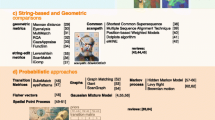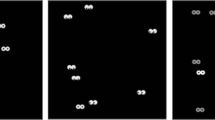Abstract
We present a new and original method for human motion analysis and evaluation, developed on the basis of the role played by attention in the perception of human motion. Attention is particularly relevant both in a multi-motion scene and in social interactions, when it comes to select and discern why and what to focus on. The first crucial role of attention concerns the saliency of human motion within a scene where other dynamics might occur. The second role, in social-close interactions, is highlighted by the selectivity shown towards gesture modalities both in peripheral and central vision. Experiments for both modeling and testing have been based on a dynamic 3D gaze tracker.
Access this chapter
Tax calculation will be finalised at checkout
Purchases are for personal use only
Preview
Unable to display preview. Download preview PDF.
Similar content being viewed by others
References
Adelson, E.H., Bergen, J.R.: Spatiotemporal energy models for the perception of motion. J. of the Optical Society of America A 2(2), 284–299 (1985)
Battelli, L., Pascual-Leone, A., Cavanagh, P.: The ”when” pathway of the right parietal lobe. Trends in Cognitive Sciences 11, 204–210 (2007)
Cavanagh, P., Labianca, A., Thornton, I.: Attention-based visual routines: Sprites. Cognition 80, 47–60 (2001)
Daugman, J.G.: Uncertainty relation for resolution in space, spatial frequency, and orientation optimized by two-dimensional visual cortical filters. Journal of the Optical Society of America 2(7), 1160–1169 (1985)
Daugman, J.G.: Complete discrete 2-d gabor tansforms by neural networks for image analysis and compression. IEEE Transaction on Acustics, Speech, and Signal Processing 36(7), 1169–1179 (1988)
Fleet, D.J., Jepson, A.D.: Computation of component image velocity from local phase information. International Journal of Computer Vision 5(1), 77–104 (1990)
Gabor, D.: Theory of communication. J. IEE 93(26, Pt. III), 429–460 (1946)
Marra, S., Pirri, F.: Eyes and Cameras Calibration for 3D World Gaze Detection. In: Gasteratos, A., Vincze, M., Tsotsos, J.K. (eds.) ICVS 2008. LNCS, vol. 5008, pp. 216–227. Springer, Heidelberg (2008)
Pirri, F., Pizzoli, M., Rudi, A.: A general method for the point of regard estimation in 3d space. In: Proceedings of the IEEE Conference on Computer Vision and Pattern Recognition (2011)
Seiffert, A.E., Cavanagh, P.: Position displacement, not velocity, is the cue to motion detection of second-order stimuli. Vision Research 38, 3569–3582 (1998)
Stelmach, L., Herdman, C.: Directed attention and perception of temporal order. Journal of Experimental Psychology: Human Perception and Performance 17(2), 539–550 (1991)
Watson, A.B., Ahumada Jr., A.J.: Model of human visual-motion sensing. Journal of the Optical Society of America A: Optics, Image Science, and Vision 2(2), 322–342 (1985)
Watson, A.B.: Multidimensional pyramids in vision and video, pp. 16–26. CUP Archive (1990)
Wildes, R.P., Bergen, J.R.: Qualitative Spatiotemporal Analysis Using an Oriented Energy Representation. In: Vernon, D. (ed.) ECCV 2000, Part II. LNCS, vol. 1843, pp. 768–784. Springer, Heidelberg (2000)
Author information
Authors and Affiliations
Editor information
Editors and Affiliations
Rights and permissions
Copyright information
© 2012 Springer-Verlag Berlin Heidelberg
About this paper
Cite this paper
Pirri, F., Pizzoli, M., Mancas, M. (2012). Human-Motion Saliency in Complex Scenes. In: Efthimiou, E., Kouroupetroglou, G., Fotinea, SE. (eds) Gesture and Sign Language in Human-Computer Interaction and Embodied Communication. GW 2011. Lecture Notes in Computer Science(), vol 7206. Springer, Berlin, Heidelberg. https://doi.org/10.1007/978-3-642-34182-3_8
Download citation
DOI: https://doi.org/10.1007/978-3-642-34182-3_8
Publisher Name: Springer, Berlin, Heidelberg
Print ISBN: 978-3-642-34181-6
Online ISBN: 978-3-642-34182-3
eBook Packages: Computer ScienceComputer Science (R0)




